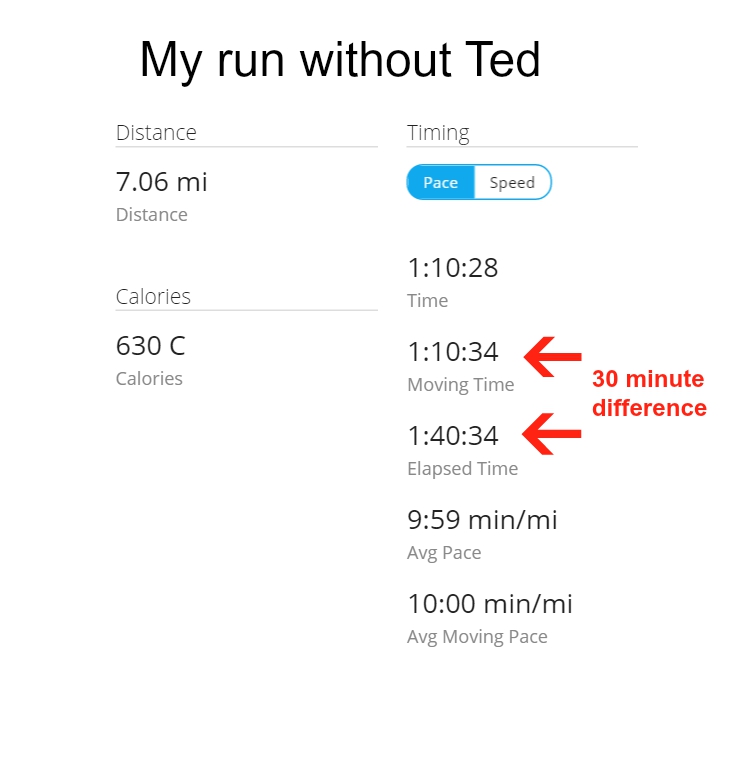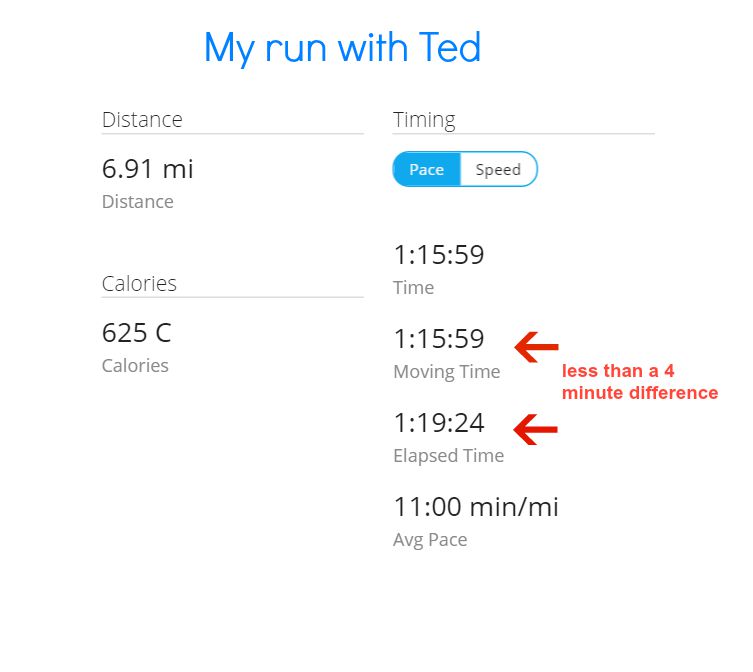Comparing elapsed vs. moving time for two long runs:The goal of my last two long runs for half marathon training was 7 miles each at 10 minute pace. The two runs went very differently. The first one I ran alone, prioritizing the 10 minute pace goal but taking a lot of breaks. The second I ran with a friend and didn’t want to burden him with a lot of breaks, so even though I had to run slower to make it happen, I ran continuously. The time elapsed vs. moving time on my Garmin helped me examine the huge difference between these two runs that ostensibly had the same goal.
Run One: I ran by myself. I was getting over a cold, so I took it *real* easy on myself when I felt like stopping. I didn’t want to walk, and I didn’t really want to slow down, so I did the entire 7 miles at 10 minute pace and modified it by stopping my watch whenever I felt like it to rest on the side of the road.
It was kind of brutal. I felt like it took forever to run the 7 miles… because it did. When I got home and looked at my Garmin connect, I discovered that I had taken THIRTY MINUTES in breaks. Garmin keeps track of the elapsed time of a run, so even when you stop the watch, it knows how long it has been since you commenced the workout. All those little breaks I took added up… and Garmin kept track. By subtracting my “moving time” from my “elapsed time” I was able to see that I added a full half hour onto my run. Time spent just standing on the side of the road thinking about how I should really start running again.

Sort of miserable.
Why I ran the next long run with company: I knew I had to do it again the next week, and I knew I had trouble pushing myself to keep the pace and eliminate breaks, so I recruited company for the run. Ted is a more experienced and faster runner, but was willing to keep me company. Knowing he was already slowing down a lot for me really kept me running through the fatigue.
Run 2: We ran 11 minute miles instead of 10 minute miles, but we did 7 miles without stopping. I was a little horrified that I’d told him my goal was to run 10 minute miles and we ended up running 11 minute miles. I was setting the pace of the run and just could. not. seem. to. go. faster.
When I first saw the splits on Garmin Connect after I got home, I was thinking why didn’t I run with Ted last week when I managed to run the 10 minute pace?
But the elapsed time tells a different story. During my run without Ted, I took 30 minutes of breaks. With Ted, we took less than 4 minutes off for navigation purposes. If you average out the pace to include breaks, that would mean my first long run averaged just over 14 minute miles. When you put it that way, I ran way faster with Ted.

I’d rather think of my first run as a whole bunch of 10 minute repeats, but the point is, the 7 miles at 11 minute pace without stopping probably served me better in terms of half marathon preparation.
I need to learn to push through the “want to stop” feeling, and keep going… because I obviously can. I think modifying the pace might be a better alteration to a long run than taking an unlimited number of breaks. I definitely don’t want to be constantly fighting the urge to take breaks when I’m running the race.
I wrote a post a few summers ago about eliminating walking breaks from your run that was very popular. Maybe I should give it a re-read 😉
In the meantime, having Ted there to motivate me to eliminate walking breaks helped me really see the stark difference between these two runs. One where I prioritized meeting my pace goal, one where I prioritized eliminating breaks.
A walk/run strategy can work really well for some people. A “take unlimited breaks whenever you feel like it” strategy prolongs runs to the point of misery. Big difference! I know I was recovering from a cold on Monday, and I respect the effort I put in to meet that target pace. I do have 7 miles at that pace in my legs that I didn’t before. But if the point of the long run is to teach yourself to keep going, I’m not sure I really did that with my first run. There’s a time for running so hard you need breaks. It’s called intervals.
Does the difference between your elapsed time and moving time tell you anything helpful about your runs?
I hear you on the elapsed time vs. running time. When I was training for my tri I was so focused on swimming that I really got a away from running. When I went back to running it was hard and I would stop and rest and that was even for 3 miles. Now I can really see my progress. I do not stop for my 3 mile runs at all. And for our last 6 mile training run, we stopped at the half way mark for water and only stopped for traffic light changes. So I’m seeing progress!
but what about the “time” field? what does this mean? how is this different to the “moving time”? I understand that “elapsed time” is from the time you press start to the time you press finish, not counting when you are not moving but what does “time” mean? In the run with Ted it is 6 seconds shorter than the “moving time”.
That’s a great question. I always assumed that time was the amount of elapsed time was the amount of time between starting the watch for the first time and stopping it for the last time on a run, time was the amount of time the watch was going for, and moving time was how Garmin would help account for breaks or stoplights if you didn’t decide to start and stop the watch on your own. Garmin support gives the same definition. That doesn’t explain why the time field would ever be shorter than moving time, however… that seems weird.